Lavender, one of my favorite herbs, is medicinal, flavorful and adds wonderful color when used properly.
You may have been directed to this site by your Lavender Stress Pouch, which I love to hand out at events. The obvious use of the stress pouch is to crush it and the breathe in the fragrance to reduce stress and to clarify your mind and senses. But Lavender's uses are limited only by the imagination.
Lavender Benefits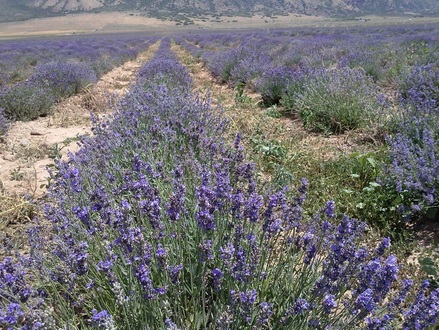
Lavender is also easy to grow and comes back faithfully year after year. I love to use my fresh flowers in recipes (see the next column), but it's also easy to purchase and relatively inexpensive. Because it is such a versatile herb, I highly recommend it as one of the first essential oils to invest in. Types of Lavender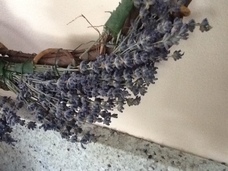
I found a great website devoted to Lavender! Mountain Valley Growers sells an assortment of organic herbs. The variety of Lavender that's available is astounding! I can't wait to begin planting next spring. You can bet I'll include as many varieties as possible in my garden next year! Let me list the varieties:
|
Lavender Recipes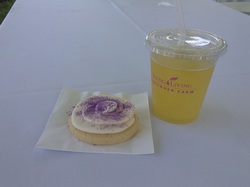
Strange how our culinary tastes vary. Not so long ago, Lavender was a popular ingredient in all types of foods and drinks. Fortunately, it's making a comeback. Below are some of my favorite recipes for Lavender. You'll find the results unique, flavorful, aromatic, and often pretty. When using Lavender for cooking, remember that it is very powerful and too much can make your product bitter.
Also, be careful of using too much in cooked foods as it may turn grey instead of the delightful purple you hope for. I'm also learning to prefer using whole lavender buds rather than grinding them into a powder. The product seems to retain the flavor but doesn't take on the gray color that powdered Lavender can produce. The buds also don't seem to be as bitter, or maybe I don't notice bitterness contained just within the buds. Lavender Teas1 teaspoon Lavender buds to 1 cup of water.
Just drop Lavender buds into hot water, stir and let steep. I'll use a sprig of fresh Lavender to a pot (4 cups) of water. If you're using dried lavender, 1/4 teaspoon per cup is plenty. Sweeten to taste. The Lavender buds will tend to drop to the bottom of the cup as they steep, but you can also strain them when you serve the sea. May be added to green teas or any other herbal teas for a fresh variation. Lavender LemonaideMake lavender tea, let it cool and then add lemon juice and sugar to taste. Again, I love to let the Lavender buds remain in my drink. You'll notice a delightfully subtle purple tinge to the drink, and the sensual Lavender aroma.
Lavender Vinegar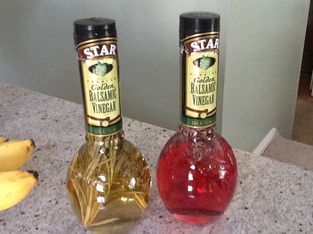
Can't be any easier than this. I purchased some white balsamic vinegar, opened the top and put in my fresh Lavender straight from my garden. I've no doubt dried lavender will work. You can see the color already beginning to take.
Lavender Honey ButterMix 1 Tbs lavender buds and 1 Tbs. Honey into 1 cup salted butter. Tasty and elegant!
Lavender Jam
Add 2 Tbls. Lavender buds to 8 cups of your favorite fruit jam recipe to create a unique flavor with a lovely flower fragrance and a slight bitterness. One of my favorite versions uses Pear jam. Pear's mild flavor really highlights the Lavender!
I have to confess - I didn't have time to make jam, so here's a picture of English muffins, whipped philly cream cheese, and Pear Jam by AmourSpreads.com, a local business (Salt Lake City, Utah) that produces wonderfully unexpected variations of jams and marmalades. Herbs De Provence from "A Taste of Lavender," by Gloria Hander Lyons, Blue Sage Press, 2007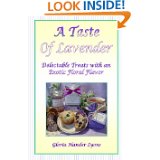
1 TBS dried oregano leaves
1 TBS dried thyme leaves 1 TBS lavender buds 1 tsp dried basil leaves 1 tsp dried sage leaves 1 tsp dried rosemary leaves Grind lavender buds in a clean coffee grinder. Finely chop or crush remaining herbs. Combine ingredients and blend. Use on roasted fish and meats, or in soups and casseroles. I love to cook with it in my crock-pot. It fills the house with a heady perfume. Lavender Sweets and PastriesI love to read recipe books. Really! I love to sit and look at the pretty pictures and read the recipes. But I rarely have time to actually make the recipe. What I've learned, though, is that you don't have to be a gourmet baker to create lavender cakes, cookies and candies. Take a favorite box of mix and add 2 tsps of lavender buds (culinary grade, of course), and you'll be surprised at how the flavor infuses the entire product! They make incredibly fun gifts!
|
Care of Lavender
|
|
I learned a lot from this video. One thing that I want to share is the importance of shaping your lavender plants as they grow. That means cutting the leaved stems back about 50% in the middle of the growing season. The result is another blast of lavender buds. It also gives me powerfully fragrant leaves that scent my entire house while they dry!
|
